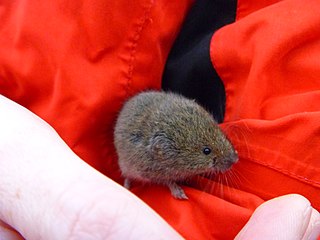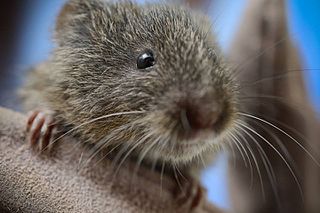
Microtus is a genus of voles found in North America, Europe and northern Asia. The genus name refers to the small ears of these animals. They are stout rodents with short ears, legs and tails. They eat green vegetation such as grasses and sedges in summer, and grains, seeds, root and bark at other times. The genus is also called "meadow voles".

The Bavarian pine vole is a vole from the Austrian, Italian, and Bavarian Alps of Europe. It lives in moist meadows at elevations of 600 to 1,000 meters.

The woodland vole is a small vole found in eastern North America. It is also known as the pine vole.

The short-tailed field vole, short-tailed vole, or simply field vole is a grey-brown vole, around 10 cm in length, with a short tail. It is one of the most common mammals in Europe, with a range extending from the Atlantic coast to Lake Baikal. These voles are found in moist grassy habitats, such as woodland, marsh or on river banks. Although they make shallow burrows, they usually build nests above ground. They are an important food source for owls and some other predators and their population size tends to peak and trough cyclically. Field voles breed prolifically, mainly in summer, but often all year round, even under snow. Females produce up to seven litters a year, each averaging from four to six young which are weaned after about fourteen days. The short-tailed field vole is both widespread and common and is listed as being of "Least Concern" by the IUCN.

The common vole is a European rodent.

The gray-tailed vole also known as the gray-tailed meadow vole or gray-tailed meadow mouse, is a rodent in the genus Microtus of the family Cricetidae. Voles are small mammals, and this species lies roughly in the middle of their size range. First collected in 1895, it is endemic to the Willamette Valley, Oregon, and Clark County, Washington, in the Pacific Northwest region of North America. Historically, they were found in the prairie areas of the Valley and, though many of these areas have been converted for agricultural purposes, these animals remain common. For reasons that remain unclear, vole population densities in any area may fluctuate widely from season to season and year to year. They are preyed upon by owls, hawks, and carnivorous mammals, and their parasites include fleas and ticks. These voles build burrows and complex tunnel networks, which they sometimes share with other burrowing animals. Relatively little is known about their behavior in the wild, because they are elusive and unlikely to enter traps.

The beach vole or Muskeget vole is a rodent in the family Cricetidae. This close relative of the eastern meadow vole is endemic to the 0.87 km2 Muskeget Island, Massachusetts. Due to its relatively short period of reproductive isolation, there is debate over the beach vole's designation as a subspecies of M. pennsylvanicus.

The Mexican vole is a species of vole.

The East European vole is a species of vole (rodent) in the family Cricetidae.

The European pine vole, also known as the common pine vole, is a species of rodent in the family Cricetidae. It is native to much of Europe and parts of Asia.
The Zempoaltépec vole is a species of rodent in the family Cricetidae. The name Microtus is from the Greek word mikros meaning small and otus meaning ear. The name umbrosus could be from the Latin umbros meaning shady. It is rather large and has a long tail when compared with other voles. Its pelage is long and soft. In the upper parts, the hair is uniformly dusky with brown tips and the lower parts a dark grey thinly washed with a reddish yellow color. It is found only in Mexico, in a semi-isolated mountain range southeast of the Cajones River in Mixes district, in Oaxaca.

The Amargosa vole is one of 17 subspecies of the California vole. The most closely related subspecies is M. californicus vallicola.

Igor Zagorodniuk is a Ukrainian zoologist, mammalogist, ecologist, and founder of Theriological school. He is a laureate of the State Prize of Ukraine in the field of science and technology (2015), and the author of more than 500 scientific publications.













